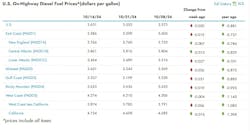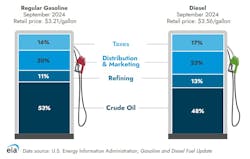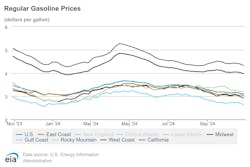Diesel costs rise in most regions, avg. $3.573/gal, gas falls, $3.097/gal
The U.S. Energy Information Administration saw diesel prices creep back up this week after a small reprieve in the wake of Hurricane Milton. While the rise and fall of diesel costs varied across the regions of the U.S.—shifting from less than a cent to 3 cents—the national average price rose by 2 cents to $3.573, still 88 cents lower than this time last year.
More specifically, diesel prices dropped in the East Coast subregions, if only a tiny amount. The New England subregion saw diesel prices dip less than a cent to $3.753, while the Central Atlantic region fell 1 cent to $3.804 per gallon. The West Coast also saw its diesel prices dip 1 cent to $4.682.
However, the other U.S. regions did not fare as well. On the lowest end of the price increases, the West Coast without California’s diesel costs rose less than a cent to $3.791. Next, the East Coast saw its diesel prices rise by 1 cent to $3.605. Meanwhile, the Midwest and the Rocky Mountain regions both experienced 2-cent jumps, with the Midwest reaching $3.569 and the Rocky Mountains reaching $3.655. The Gulf Coast, on the other hand, saw a price shift of 3 cents to $3.230.
These small changes were not enough to change which states are the cheapest or most expensive places to buy diesel fuel, with the Gulf Coast still the most cost-effective at $3.230 and California as the most expensive at $4.682.
Looking back, EIA also found that, after the cost of crude oil, distribution and marketing had the most significant impact on diesel prices in September. Working off of a retail price of $3.56 per gallon, crude oil accounted for 48%, or $1.70, of the total cost of diesel at the pump. Distribution and marketing followed up at 23% of the cost of diesel, or 81 cents, followed by taxes taking up 17%, or 60 cents, of September’s costs. Refining accounted for the lowest prices at the pump at 13%, or 46 cents.
For reference, the AAA motor club logged a current diesel average of $3.569, which is 1 cent cheaper than the EIA and 3 cents less than the motor club’s reckoning last week of $3.590. According to the organization, the current price is also 91 cents less than this time last year when it was $4.485.
Gas prices fall across the U.S.
Unlike diesel prices, gasoline prices have continued to decline relatively slowly across the country. The national average gas price is currently $3.097, 4 cents lower than last week and 37 cents lower than last year. For each region specifically, prices tended to shift from less than a cent to 8 cents overall.
The only area that saw their prices rise was the New England subregion, where costs rose less than a cent to $3.044. Meanwhile, prices dropped less than a cent along the East Coast to $3.045 and 4 cents along the West Coast not including California to $3.600. The West Coast overall experienced a 6-cent price decrease to $3.973, followed by the Gulf Coast with a dip of 7 cents to $3.646. Both California and the Midwest saw prices drop by 8 cents to $4.326 and $2.932 per gallon, respectively.
With all of this in mind, the Gulf Coast is still the cheapest place for gas at $2.646 per gallon, while California is the most expensive at $4.326.
For comparison, the AAA gas average is currently $3.130 per gallon, 4 cents lower than last week’s $3.175 and 37 cents lower than last year’s prices of $3.503.






